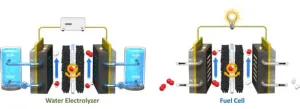(Press-News.org)
· Temperature sensor warns of disease flareups, tracks disease progression in real time
· Currently no way to quickly detect inflammation, leading to invasive surgeries
· Strategy could be useful in ulcerative colitis, another inflammatory bowel disease
CHICAGO --- A team of Northwestern University scientists has developed the first wireless, implantable temperature sensor to detect inflammatory flareups in patients with Crohn’s disease. The approach offers long-term, real-time monitoring and could enable clinicians to act earlier to prevent or limit the permanent damage caused by inflammatory episodes.
More than 1 million Americans have Crohn’s disease, a chronic inflammatory bowel disease that affects the intestines, causes digestive issues and can lead to weight loss, malnutrition and other complications. People with mild cases are treated with oral medications, but these drugs typically fail over time, requiring approximately 70 percent of Crohn’s patients to undergo at least one surgery to remove portions of damaged intestines.
Because heat is indicative of inflammation, the Northwestern scientists tested whether a temperature sensor resting gently against the intestines of mice with Crohn’s disease could provide real-time insight into the progression of the disease, as well as detect episodic flareups. Sure enough, they accomplished both goals in their research, which will be published online March 18 in the journal Nature Biomedical Engineering.
Arun Sharma, whose group led the animal testing, said there is currently no way for clinicians to quickly detect inflammatory events, some of which go unnoticed by patients until the problem becomes so severe that it requires invasive surgery.
“The magnitude of the flareup can be measured with regards to the heat signature,” said Sharma, co-corresponding author on the paper and a research associate professor of urology at Northwestern University Feinberg School of Medicine and of biomedical engineering at McCormick School of Engineering. “Is it so extensive that it’s going to cause tissue damage over time?
“This could be potentially prevented if a clinician has this information readily at hand and can determine what type of therapy can be given to that person at that moment in time, rather than waiting weeks to get a blood analysis, tissue biopsy or fecal analysis. In the meantime, you’re losing valuable minutes regarding tissue damage with this inflammatory event.”
Sharma said this strategy of measuring temperature fluctuations could also be useful for patients with ulcerative colitis, another inflammatory bowel disease, or any condition where there is a prolonged inflammatory response. In their study, the researchers used the wireless sensors to continuously track temperature fluctuations for nearly four months.
Bioelectronics pioneer John Rogers, whose group led the device development, recently published another paper describing an ultrathin, soft implant that measures temperature and perfusion changes as a way to monitor the health of transplanted organs. Once again, the relationship between heat and inflammation was key, as excess inflammation around the transplanted organ can offer an early warning sign that the new organ is being rejected by the patient’s immune system.
“To address Crohn’s disease, we developed an ultraminiaturized, precision temperature sensor with wireless communication capability,” said Rogers, co-corresponding author on the paper. “This tiny, soft device takes the form of a smooth, round capsule that rests within the GI system, without affecting natural physiological processes for long-term recordings. The data show some very unique signatures, in the form of perturbations to natural circadian cycles, known as ultradian rhythms, as early indications of inflammatory responses.”
The scientists discovered that the ultradian temperature rhythms correlate to cyclic variations in stress levels and inflammatory markers in blood, said Surabhi Madhvapathy, co-first author from Rogers group who led the sensor engineering.
“In addition to the short-term variations, we learned over the span of weeks to months, that the average temperature of the intestines decreases,” Madhvapathy said. “This decrease was indicative of the worsening tissue quality over time.”
Following these successful results in mice, the researchers plan to assess the sensor capabilities in human tissues that recreate the inflammatory gut conditions found in Inflammatory Bowel Disease.
Rogers is the Louis Simpson and Kimberly Querrey Professor of Materials Science and Engineering, Biomedical Engineering and Neurological Surgery at McCormick and director of the Querrey Simpson Institute for Bioelectronics, which supported the study. Sharma is director of Pediatric Urological Regenerative Medicine and Surgical Research at Ann & Robert H. Lurie Children’s Hospital of Chicago and the Stanley Manne Children’s Research Institute, and a member of Northwestern’s Simpson Querrey Institute for BioNanotechnology.
Surabhi Madhvapathy of the Rogers group and Matthew Bury of the Sharma group are co-first authors of the paper.
The title of the paper is “Miniaturized implantable temperature sensors for the long-term monitoring of chronic intestinal inflammation.”
END
A new study led by researchers at McLean Hospital (a member of Mass General Brigham) and Washington State University used advances in digital testing to demonstrate that naturally occurring glucose fluctuations impact cognitive function in people with Type 1 Diabetes (T1D). Results showed that cognition was slower in moments when glucose was atypical – that is, considerably higher or lower than someone’s usual glucose level. However, some people were more susceptible to the cognitive effects of large glucose fluctuations than others.
“In trying to understand how diabetes impacts the brain, our research shows that it is important to consider not only how people ...
NEW ORLEANS, March 18, 2024 — Doctors have long prescribed exercise to improve and protect health. In the future, a pill may offer some of the same benefits as exercise. Now, researchers report on new compounds that appear capable of mimicking the physical boost of working out — at least within rodent cells. This discovery could lead to a new way to treat muscle atrophy and other medical conditions in people, including heart failure and neurodegenerative disease.
The researchers will present their ...
NEW ORLEANS, March 18, 2024 — Buildings and production of the materials used in their construction emit a lot of carbon dioxide (CO2), a potent greenhouse gas that contributes to global warming and climate change. But storing CO2 in building materials could help make them more environmentally friendly. Scientists report that they have designed a composite decking material that stores more CO2 than is required to manufacture it, providing a “carbon-negative” option that meets building codes and is less expensive than standard composite decking.
The researchers will present their results today at the spring meeting of the American Chemical Society ...
NEW ORLEANS, March 18, 2024 – During cold and flu season, excess mucus is a common, unpleasant symptom of illness, but the slippery substance is essential to human health. To better understand its many roles, researchers synthesized the major component of mucus, the sugar-coated proteins called mucins, and discovered that changing the mucins of healthy cells to resemble those of cancer cells made healthy cells act more cancer-like.
The researcher will present her results today at the spring meeting of the American Chemical Society (ACS). ACS Spring 2024 is a hybrid meeting being held virtually and in person March 17-21; it features nearly 12,000 ...
Research from the University of Southampton has identified common issues women face when experiencing periods while homeless.
A review of research published in Women and Health has found homeless women experienced practical challenges in managing menstruation alongside feelings of embarrassment and shame, with many ‘making do’ due to inadequate provision.
The researchers say it’s high time to address the provision of menstrual health resources as a basic human right.
Dr Stephanie Barker, a teaching fellow at the University of ...
Your skin becomes red and spots filled with pus appear, so you visit a dermatologist. When these symptoms spread to the skin throughout the body, it is difficult for the physician to distinguish whether it is generalized pustular psoriasis (GPP) or acute generalized exanthematous pustulosis (AGEP), as both have similar symptoms. The two diseases run different courses and require different treatments. Without proper treatment, the symptoms can worsen severely and cause complications, so it is essential to distinguish between them.
Researchers ...
Dr. Hyung-Suk Oh and Dr. Woong-Hee Lee of the Clean Energy Research Center at the Korea Institute of Science and Technology (KIST), in collaboration with POSTECH and Yonsei University, have developed a methodology to improve the reversibility and durability of electrodes using bifunctional platinum-nickel alloy catalysts with an octahedral structure that exhibits both oxygen reduction and generation reactions.
Bifunctional catalysts are a new generation of catalysts that simultaneously produce hydrogen and oxygen from water using a single catalyst. Currently, electrochemical systems such as water electrolysis technology and CCU (carbon dioxide ...
NEW ORLEANS, March 17, 2024 — Unique adaptations allow wild animals to survive temperature extremes that would quickly kill an unprotected human. For example, certain animals can withstand bitterly cold weather, thanks to the insulating properties of the hollow hairs that make up their coats. Little has been known about the hairs, but now, researchers have discovered that their inner structure changes with the seasons.
The researchers will present their results today at the spring meeting of the American Chemical Society (ACS). ACS Spring 2024 is a hybrid meeting being held virtually and in person March ...
NEW ORLEANS, March 17, 2024 — Insects are typically unwelcome visitors to a picnic, but they could be a flavorful, nutritious and sustainable addition to the menu. Eating insects is common in some parts of the world, and some species are even considered delicacies. Ants are one example, sometimes roasted whole for a snack or ground and used to add flavor and texture to dishes. Researchers now report the unique aroma profiles of four species of edible ants, which taste markedly different from one another.
The researchers will present their results today at the spring meeting of the American Chemical Society (ACS). ACS Spring 2024 is a hybrid meeting being held ...
NEW ORLEANS, March 17, 2024 — Kombucha is a fermented tea known for its health benefits and tangy kick. But brewers can find it challenging to keep kombucha’s alcohol levels low because the bacteria and yeast used in the fermentation process vary from batch to batch. Now, chemists from Shippensburg University are investigating ways to reliably minimize alcohol, tailor taste profiles and speed up the kombucha fermentation process to help home and commercial producers optimize their funky brews.
The ...







